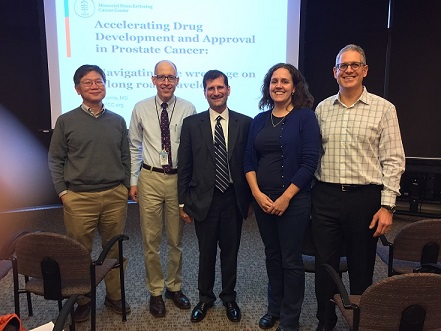Prostate Cancer
Development of pain end point models for use in prostate cancer clinical trials and drug approval



Posted June 27, 2017
Ethan Basch, M.D., M.Sc., University of North Carolina, Chapel Hill
Antonia Bennett, Ph.D., University of North Carolina, Chapel Hill

Pain is common in men with metastatic prostate cancer (PCa) and can substantially interfere with their daily activities, sleep, and quality of life. Regulatory standards for the design of symptom endpoints for clinical trials have evolved over the past decade and approaches previously used to assess cancer-related pain and analgesic use are no longer considered sufficiently rigorous. It is therefore essential that standards for assessing pain in PCa patients be developed, in partnership with the FDA and PCa research leaders, so that scientists and drug companies can successfully include pain assessments in clinical trials. To accomplish this, Dr. Ethan Basch and his colleagues at the University of North Carolina, Chapel Hill, sought to further understand the burden of pain in men with advanced PCa and how PCa drugs affect their pain.
Another important aspect of developing a pain endpoint model is a patient's willingness to provide relevant information during the course of a clinical trial. To evaluate this, Dr. Basch's team has partnered with industry to analyze data from a feasibility study of pain assessment nested within an industry-sponsored phase II treatment trial conducted in the PCRP-funded Prostate Cancer Clinical Trials Consortium. To date, they have enrolled patients from five centers across the country and will complete data collection in September 2017. Their recently published findings from this phase II study reported that the drug cabozantinib demonstrated clinically meaningful pain palliation, reduced or eliminated patients' narcotic use, and improved patient functioning, thus meriting prospective validation in phase III studies. Lastly, Dr. Basch sought to generate a published guideline that could be used for evaluating pain endpoints in future trials. He conducted a consensus meeting with investigators in the Prostate Cancer Clinical Trials Consortium, FDA Office of Oncology Drug Products, FDA Study Endpoint and Label Development Team, and FDA Division of Anesthesia, Analgesia and Rheumatology Products, and was able to successfully establish discrete guidelines delineating key methodological components of pain studies in prostate cancer, which were published in Cancer.
This compendium of work will enable the evaluation of pain in clinical trials and improve our understanding of how PCa drugs affect pain. Ultimately, Dr. Basch hopes this work will lead to better pain management and improve the quality of life for men with advanced PCa.
With funding from a FY10 PCRP Idea Development Award, Dr. Basch and his research team have taken three distinct, but inter-related approaches to develop a pain endpoint model. In order to establish the key elements of how best to measure pain in clinical trials, they first analyzed rates of pain progression and palliation among patients with metastatic castrate-resistant PCa (mCRPC). Through surveying men with mCRPC starting new systemic therapy every six weeks for 26 months, they determined that moderate to severe pain was common and a majority of patients had increases in pain over time (Table 1), thus solidifying the need for further studies to alleviate pain in this patient population.
Table 1. Median time to event and rates of pain palliation and pain progression among men with mCRPC starting a new line of systemic therapy
| Baseline pain status* | Event | Proportion with Event | Median Time to Event (Kaplan-Meier) |
|---|---|---|---|
| No pain | Developed pain | 17/22 (32%) | 24 weeks 95% CL = [18, 36] |
| None or mild pain | Developed moderate or severe pain | 31/57 (54%) | 36 weeks 95% CL = [24, 72] |
| All patients: None, mild, moderate or severe pain | Pain progression | 32/130 (25%) | 84 weeks 95% CL = [66, NA] |
| Pain (any) | Pain progression | 25/108 (23%) | 84 weeks 95% CL = [66, NA] |
| Moderate or severe pain | Pain progression | 15/73 (21%) | 78 weeks95% CL = [66, NA] |
| Moderate or severe pain | Pain palliation | 8/73 (11%) | Non-estimable |
|
*Pain Status Definitions: |
|||
| No pain | No reported pain nor any analgesic use | ||
| Pain (any) | Pain >0 or any analgesic use | ||
| None or mild pain | Pain <3 and no prescription analgesic use | ||
| Moderate or severe pain | Pain =3 or prescription analgesic use | ||
Publications:
Basch E, Autio KA, Smith MR, et al. 2015. Effects of cabozantinib on pain and narcotic use in patients with castration-resistant prostate cancer: Results from a phase 2 nonrandomized expansion cohort. Eur Urol 67(2):310-318.
Basch E, Trentacosti AM, Burke LB, et al. 2014. Pain palliation measurement in cancer clinical trials: The US food and drug administration perspective. Cancer 120(5):761-767.
Link:
Development of Pain End Point Models for Use in Prostate Cancer Clinical Trials and Drug Approval
Last updated Monday, March 10, 2025














